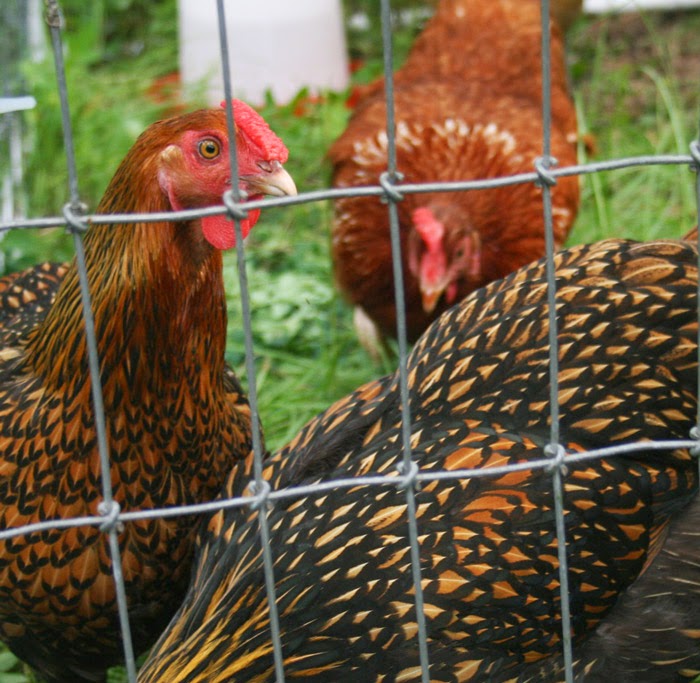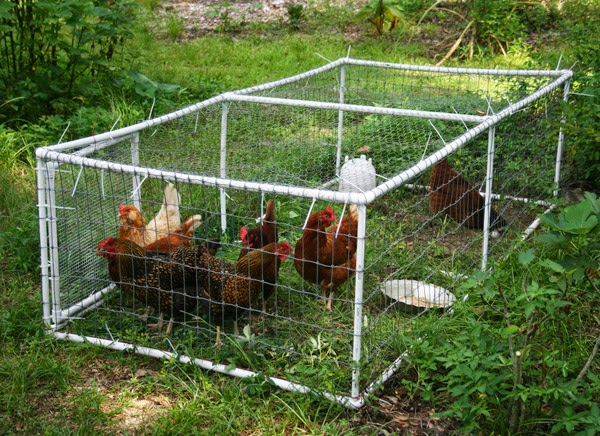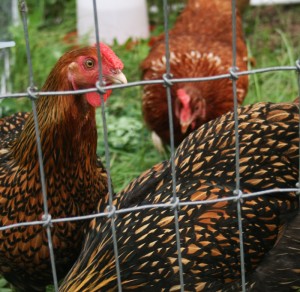I received the following e-mail last week:
Subject: Help with chickens
David,
My name is [K. L.] and I live in the [mid-Florida] area, most recently I stumbled upon your YouTube site which then led me to your website. I thoroughly enjoyed your videos and blog post that I have watched and read and would like to ask you for some advice. Currently I have a small garden that is under construction to increase it to a 50′ x 25′ garden, which I enjoy working in and producing food for my wife and I but I would like to add some chickens to the equation. I have never had chickens and really know little to nothing about what I need other than the coop has to be critter proof. I will definitely need critter proof because although I live in a neighborhood, I also live in the forest. I should also tell you that I’m only looking to have eggs right now so any advice on what type of chickens I need would be great. I guess basically I need Chickens 101. Lol. Any help or advice you could give me I would really appreciate it.
Thank you and God Bless,
K
Well… lots of questions there. Today I’ve decided to start a short series of “Chickens 101” posts to share what I’ve learned about these oh-so-useful backyard birds.

We’ve kept chickens for years and have had plenty of problems we discovered along the way. When you think you have it all figured out, it’s usually about time for something else to go wrong.
Let’s start with housing.
Chicken Tractors vs. Chicken Coops
1: Chicken tractors
I spent a lot of time on the internet researching chickens before and after moving to the country. This made me think that chicken tractors were the best way to go.
My first chicken coop was a chicken tractor I designed as a 4′ x 4′ x 8′ rectangle. About six foot of its length was screened in with chicken wire and the last 2′ had space for the birds to nest at night and lay their eggs.
It was made from solid pressure-treated wood with a metal roof, stained a rich brown color… and it weighed a ton.
I intended on keeping it in the yard of our rental house but even moving it there was a huge pain. It ended up in a former cousin’s yard, then later ended up being disassembled for parts.
FAIL
2: Chicken Coops
My second chicken coop design was a more standard affair. We had an old shed so I converted that to a chicken coop over a weekend. We added nest boxes and nailed up some tree limbs so they could roost. I also found some pictures of Elvis the previous homeowner had left in the attic, so I hung those up for the birds. Chickens instinctively like Elvis.
We found that the chickens took to roosting in the rafters of the shed, which was dangerous both for them and for us. When the door was opened in the morning they’d come crashing down like drunk vultures from eight feet in the air, tearing towards the light.
That was remedied by the addition of some old fencing over the rafters so they could no longer make their way up that high.
Around the coop door, we fenced a chicken run that was about 20 x 30′ in size and mostly shaded by an oak tree.
It was a nice place for chickens.
However, the raccoons went after and killed some of our birds despite our best efforts. If we forgot to shut the birds in at dusk, some would be murdered in the night.
That was a pain. It meant that if we wanted to go to dinner with some friends or had an evening church service, we needed to chase all the birds back into the coop and shut it early.
Pro-tip: Herding chickens isn’t easy in dress shoes
The standard coop design did keep the chickens safe as long as we shut the door, but they did strip the weeds and grass in their run down to compacted sand over a few months. Not particularly permaculture or friendly to the ground or the birds.
After a time, I decided to remedy this by designing some new chicken tractors so I could put at least some of the birds to work in the gardens and the food forest.
3: Chicken Tractors Again
This time I used lighter materials and made some simple triangular-topped chicken tractors from 2 x 2″ lumber and chicken wire. They didn’t take long to make and worked a lot better than my previous design. At 3′ x 8′ with about 4′ height in the middle, they held 6-8 birds well.
I didn’t bother putting a true covered roost area in these. Instead, I stapled old feed bags over one half of the tractor for rain and sun protection and just left the other side open.
Dragging them around was a bit of a pain, though. We invariably broke eggs (the birds nested on the ground in this design) and sometimes birds would get their legs pinched if we moved too quickly.
After a time, I got tired of these tractors, my main chicken coop, the losses to raccoons and the feed bill… and we got rid of our chickens altogether.
For a while.
But I couldn’t help it – I had to take them up again, and when I did, I went back to tractors. Shiny new tractors with PVC and good wire. And I got a new flock of healthy pretty birds with bright eyes and flappy little wings.

And then the raccoons started taking them, usually one at a time, but not every night. Just here and there.
The worst night was when I had just raised a new round of chickens in the incubator, gotten them bigger and stronger in a tub on the back porch, and then put them in a new chicken tractor.
Two nights afterwards all of them were murdered by a racoon.
All 16 birds.
It was the worst chicken day ever and it led to me putting wire on the bottom of all my chicken tractors.
That wired bottom was a pain, however. The chickens would get their feet stuck in it – and it kept them from digging up the ground nicely and eating the grass and weeds, which is one of the main reasons I wanted them in tractors to begin with.
So – what’s the final answer in the battle of chicken tractors vs. chicken coops?
…stay tuned!


8 comments
Sounds like both have their draw backs and perks. Best of both worlds might be a mobile hen house. This with a temporary fencing for their run or a few paddocks to run them through circulating from week to week.
I’ve had chickens for awhile now. I preferred free ranging them. You lose some once in awhile. I was down to six last summer so I bought an incubator. I was pretty proud that I hatched 10 out of 11. Raised them up and put them in a tractor. A raccoon got 8 out of 10. I caught one coon in a trap and poisoned another one.
So this summer, I was going to hatch some more. The days were just getting long enough that they were starting to lay again, and the neighbor’s dog killed all but one. So now I have a lone hen. She’s pretty lonely. Of course, I ordered a dozen pullets and a couple roosters. Only one died so far.
Chickens are just extremely prone to disaster. You either keep them cooped up and lose half the benefit and fun of having them, or have enough replacements in the pipeline. And show no mercy to predators. That dog will get it eventually.
Yeah, “prone to disaster” is a great way to put it.
BTW, do any writing lately, bro?
Nope. I remember the good old days back at the Friday challenge. But life gets in the way, and then you read something John C Wright wrote, and despair at ever being a writer. Biggest problem is ideas.
John C. Wright is six kinds of awesome. By my count, this leaves at least 1,347 kinds of awesome open for investigation, so go for it!
Yes!
See this, http://davidsfollyfarm.blogspot.com/2011/06/chickshaw.html
Quite clever – I like it! Thank you for sharing.
Comments are closed.